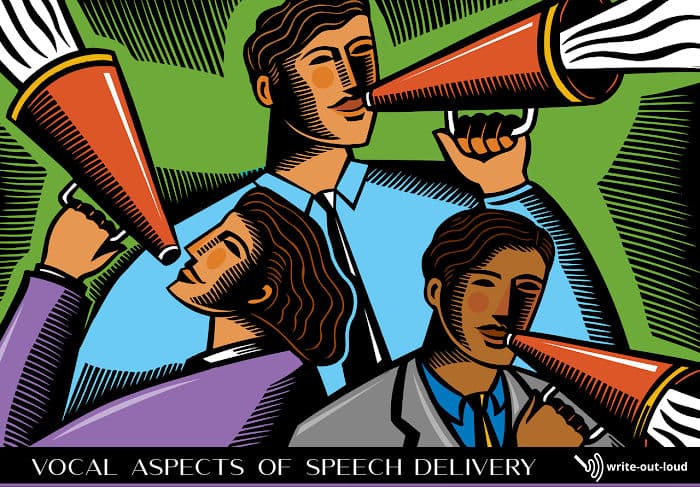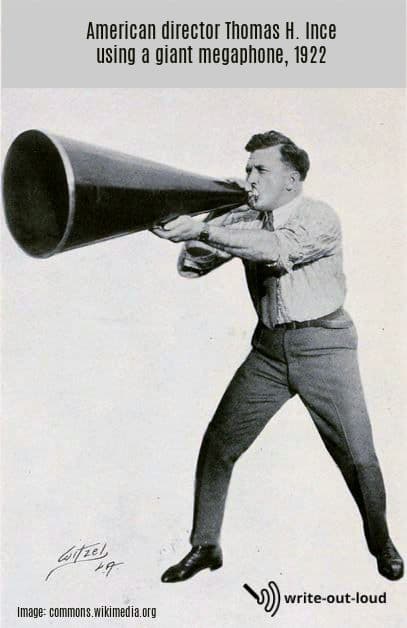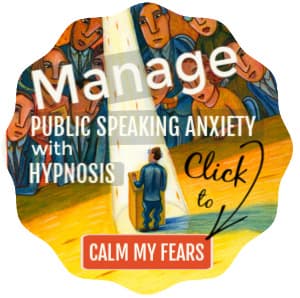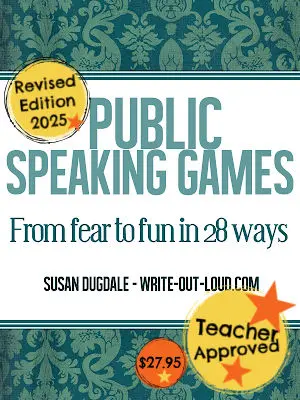- HOME ›
- Speech delivery ›
- Vocal aspects of speech delivery
Vocal aspects of speech delivery
9 features of effective speech delivery, plus how to maximize your vocal potential
By: Susan Dugdale
There's an old saying, one I'm sure you will have heard over and over again: It's not what you say, but HOW you say it.
It means the way you deliver what you have to say, significantly influences how the people listening will respond.
Will they be interested? Will they want to hear more? Will they lean forward in their chairs? Will they smile?
Or will they politely switch off? Turn away? And, less politely, fiddle with their phones?
Those responses, the positive and the negative, interested or disinterested, are in part determined by the affect of the vocal aspects of your speech on your audience.

What's on this page
- how we speak matters - how the quality of our voice's impact on our lives
- the nine vocal aspects of speech delivery
- how to make your voice work for you
- how to get an overview of your voice quality
- how to work with each of the nine vocal aspects of speech delivery: tips, exercises and links to further resources
- references
How we speak matters
It's not ALL about content; the words we say. We could be sharing something of real interest and benefit to our listeners. However if we deliver it in a way that fails to engage them, it is more likely to be ignored and quickly forgotten.
Scholarly research confirms this. (*Check the foot of the page for references.)
The outcome of a job interview, a business proposal, a sales presentation, or an important oral communication of any sort is influenced by voice quality. As is how effective we are as leaders, teachers, call center workers, pastors, and reporters.
In any sphere dependent on voice we judge each other, consciously or unconsciously, based on the quality of speech we hear.
We decide this person doesn't really know what they're talking about because every second word they use is a filler: an um, an ahh, or a 'like'. That one is intelligent because their voice sounds authoritative: confident and strong and this woman will never inspire respect because her voice is too high and too breathy.
How we speak matters. In some instances, it matters a great deal.
Nine vocal aspects of speech delivery
The overall quality of speech delivery comes from a blend of nine distinct vocal aspects.
These are:
Your voice is a powerful personal advocate
The broad characteristics of our voices are dictated by biological inheritance, for instance whether they are typical male (lower register) or female (higher register) voices. That aside, barring impairment, many habitual unhelpful speech mannerisms can be modified.
We do not need to be a victims of our own voices. A voice can be trained and vocal habits changed.
Often a person will be strong in some areas, and weaker in others.
For example, you may have excellent volume but speak too quickly.
Or perhaps you have very little tonal variation which, unfortunately, makes you boring to listen to! However your pronunciation and articulation are good.
Your voice is potentially your most powerful personal advocate. It speaks for you, embodying and carrying your message.
Making your voice work well for you
To realize its power, to maximize its vocal potential, what's needed is:
- an awareness of how we habitually speak and how that might be impacting on our lives,
- the willingness to change,
- and, the determination to persevere, to keep practicing.
Developing good, flexible vocal delivery does not mean denying your roots, for instance, removing any traces of accent or any other cultural, or class, identifiers. It is about recognizing, honoring and working with your voice to fully empower yourself to achieve what you want to.
Start from where you are
The place to start is to find out as much you can about your current vocal habits.
If you've don't belong to a public speaking group, like Toastmasters International, where feedback on how you speak is an essential part of the program, this can be a bit tricky.
Ideally what you want is an objective overview highlighting the areas needing attention.
If any of your presentations have been recorded, play them back. Look, listen and list the areas you are weakest in. That's where you start.
If you don't have recordings, perhaps you have a mentor, a trusted work colleague, or friend who has seen and heard you present. Ask them for feedback. Be specific about you want from them. Generalized comments are not useful. What you need is information like:
- It would be good to consider the tone of your words. What fits one setting doesn't necessarily fit another. Talking about "bros" at our last formal business meeting didn't go down well, even if you were joking.
- Do try going slower, especially when you're covering new material. I noticed some people struggling to keep up.
- The volume of your voice is good. Everybody can hear you quite comfortably.
(If you want it, here's more on asking for and giving speech evaluations. The page includes a link to a printable speech evaluation form.)
Make your own recordings
If you don't have recordings of presentations and you don't feel you can ask someone for feedback, the last option is make recordings of yourself across a range of different types of material.*
- Read aloud or retell 1 - 2 minutes of well known child's story eg. The Three Little Pigs.
- Read aloud for 1 -2 minutes from an informative article on a subject you know little about.
- Make an impromptu speech 1 - 2 minutes long on a subject on your choice. (Click this link and you'll find dozens of impromptu speech topics to choose from.)
Play back your recordings, and listen as objectively as you can. What do you notice?
Too fast? Not enough pausing between one idea and the next next? Stumbling over certain words? A monotone delivery? Lots of filler words?
Choose the most glaring as your starting point.
*There is a difference between reading aloud and speaking aloud because they call on different skills. What you hear when you play back your recordings will give you an indication of what you habitually do, rather than being definitive. But that's good enough to work with!
Working with pronunciation
"You like "po-tay-to" and I like "po-tah-to"
You like "to-may-to" and I like "to-mah-to";
Po-tay-to, po-tah-to, to-may-to, to-mah-to! Let's call the whole thing off!"
The famous lyrics from the 1937 song Let's Call the Whole Thing Off by George and Ira Gershwin highlights differences in American and English pronunciation, as well as class distinction. (A British accent is so much more refined, my dear. ☺)
The song, a jazz classic, has been covered by many great singers over the years. Here is the original version by Fred Astaire and Ginger Rogers, from the 1937 show "Shall We Dance". (To watch a YouTube clip of their song and dance routine, click the image.)
The song also highlights the age old debate about the 'right' way to pronounce words.* That said, some ways really are better than others.
Pronounce names correctly
It's always good practice to take care to pronounce any name, (a person's, a country's, etc.), as best you can, to ask for a demonstration if you don't how to begin tackling it, and to apologize for mangling it if you're completely unaccustomed to producing its sounds correctly. That shows courtesy and respect.
Look those strangers up!
You don't have to muddle around guessing how words you don't know, or that you've never heard spoken, might sound.
One the easiest ways of finding out is to look them up in an online dictionary. You'll find audio clips along with all the other information generally found in a hard-copy dictionary.
Here's an example for the word 'advocate' from the Cambridge English Dictionary. Directly under the main heading there are two audio clips: one demonstrating a UK pronunciation and the other is US.
Accent and pronunciation
Everyone has an accent, whether they think so or not!
The type of accent we have depends on our first language or mother tongue. It's from that we develop our primary linguistic habits: how we use our mouths (lips, teeth, lips etc.) to shape the sounds of words, and the rhythmic, tonal and pitch patterns we habitually use.
An accent becomes more noticeable to others when:
- we move away from the people we grew up with - eg. go to live in a different part of the country, or another country. For example, although English is the primary language in UK and USA, there are multiple regional differences in each of them. The English spoken in Newcastle, England is vastly different to that spoken in the southern US states. (To hear the difference click: How To Do A Southern Accent FAST and then click: Learn A Geordie Accent | Newcastle Accent Tutorial.)
- we speak another language. Unless we are extremely good at absorbing and replicating the unique sounds of differing languages, what we tend to do is to superimpose the second (third, fourth...) language we learn over our first. So if we grow up speaking Hindi or Chinese Mandarin, our English naturally echoes that patterning.
When accent becomes a problem
Accent only becomes a problem if the people you're speaking to can not readily understand you. If you are regularly asked to either slow down or repeat what you've said then it's time to do something about it.
Unfortunately if you make people work too hard to grasp what you're telling them you may find yourself being avoided because communicating with you is tiring. That has all sorts of potentially difficult knock-on effects!
Three ways to lessen the impact of an accent
1. Identify the sounds that challenge you
Identify the specific sounds and letter combinations you have difficulty with. The most common are 'th,' 'v' and 'w,' and 'l' and 'r'.
Find out how they should be sounded. What shape is the mouth? What work does the tongue do to produce the sound? Practice, a lot, and use a mirror to look while you are doing it to check that you are replicating it is as best you can.
It will feel most strange, however persevere.
Here's a link to Mrs Tongue Does Her Housework - a set of tongue exercises for articulation. They'll help.
2. Slow down
If you have an accent you know listeners find hard to understand, help them by slowing the rate of your speech down. When you speak more slowly you'll quite naturally be more careful with your pronunciation.
3. Read aloud
Read out loud, and do it regularly every day. It could be a child's story, a newspaper article... anything at all.
Follow the patterning of the punctuation as a guide for when to change your intonation and to pause. And try to sound the ends of the words cleanly.
Every few days record at least a minute of yourself, and keep the samples. Over time you'll hear the progress you're making.
For more on using punctuation to help you deliver speech well, please see effective tips for using pauses in speeches. You'll find step by step guidelines for practice with audio examples.
A language lives, therefore it changes!
*English word usage and pronunciation shifts and changes with its speakers and the times. It's a living dynamic language. What was 'right' fifty years ago may now be a quaint remnant from a bygone era. To a large extent 'right' pronunciation depends on who is speaking, who is listening and where they are. Context is everything.
Working with articulation
To articulate well, is to speak distinctly or clearly. It is to say 'want to' instead of 'wanna', 'don't you' instead of 'doncha' and 'going to' instead of 'gunna'.
You can articulate beautifully while pronouncing a word incorrectly, and vice versa.
(Often the mispronunciation comes from having a read a word and never hearing it used in conversation. Those silent letters can cause so much confusion! Debris is not pronounced 'de-bris' but 'de-bree'. And similarly debut is not 'de-but' but 'day-boo'.)
Mumbling, indistinct articulation, and slurring, running words together instead of leaving spaces between them, makes it hard for people to understand what you're saying.
Although it might be regarded as normal in an informal setting, in a formal one, for instance giving a presentation to colleagues, it can lessen your credibility. It's interpreted as a lack of authority, confidence and competence, as if you don't know what you're talking about.
If you know you mumble, and slur your words together, try tongue twisters. These are fun and effective.
Working with pitch
Pitch refers to how high or low a voice is.
The voice range, the pitch at the top if we speak as high as we can comfortably, and the bottom if we speak as low as we can, is governed by physiology: the size of the larynx plus the length and thickness of our vocal cords.
Men have a lower pitch range, and women higher, mostly due to difference in body sizes.
Studies have shown voice pitch directly influences our choice of leaders. We attribute wisdom, authority, experience, competency and confidence to people with lower voices.
Despite the range being fixed we can still vary the pitch to better fit what we are speaking about, and who we are speaking to.
For example: if the subject is important and a point needs to be made, lower the pitch.
If you want to signal the end of a sentence, or the wrap up of a subject, lower the pitch.
If you want to signal excitement and enthusiasm, lift the pitch.
Experiment with pitch
Try these this exercise. It quite clearly illustrates the potential and power of pitch.
Record yourself as you say each of the sentences below at the top, middle and bottom of your pitch range.
Play them back. Notice what happens to the intensity and the way you perceive the emotional content of the sentences. There will be a distinct variation between each.
- Her Grandmother died yesterday.
- I want a new car.
- This dinner is delicious.
- People should love their neighbors as themselves.
Keep playing. Read an article aloud, a children's story, a recipe book..., anything. The idea is to develop flexibility - to be able to choose appropriately, knowing what the impact of the pitch of your voice is likely to have on your audience.
Voice pitch and leadership
Studies have shown voice pitch directly influences our choice of leaders. We attribute wisdom, authority, experience, competency and confidence to people with lower voices.
For more please see:
- How Voice Pitch Influences Our Choice of Leaders by Casey Klofstad, Stephen Nowicki & Rindy Anderson, American Scientist, 2016, Vol.104. No.5
- Sounds like a winner: voice pitch influences perception of leadership capacity in both men and women by Susan Peters, Casey Klofstad, & Rindy Anderson, Proceedings of the Royal Society, 2012, Volume 279, Issue 1738
Working with tone

How many times have you heard someone say: "Do not speak to me in that tone of voice!"?
What they're responding to is not the words they heard but HOW they were delivered. It's their perception or understanding of the speaker's intent or feeling. They're listening beyond the words.
As an example I made three recordings of "Do not talk to me in that tone of voice."
You'll hear differences in speaking rate (the speed the words are said), pitch, stresses (which words, or syllables of a word, have been given more emphasis), pausing (the silences between the words), volume and the amount of breath used. The combination of all these elements creates tone.
Although the words are the same, the recordings carry differing messages.
- Do not talk to me in that tone of voice
- Do not talk to me in that tone of voice
- Do not talk to me in that tone of voice
The first says I'm becoming extremely irritated by the way you are speaking to me. I do not like it, and I'm warning you that if you persist there may be consequences!
The second says I find you really attractive and amusing, despite your cheekiness! The tone contradicts the meaning of the words.
The third says I'm agitated and distressed about how you talking to me. It makes me feel very anxious. Stop being so mean!
Becoming conscious of tone
Taking control of tone means aligning your true speech intent, or purpose, with your content, and your audience. For credibility you need all three working together harmoniously.
"I am really happy to be here.", delivered as if you are utterly bored and can't wait to get out the door is not going to build confidence in anything else you say! Likewise a serious message can be completely undermined through a flippant, breathy, 'like', 'um', 'ah' filled delivery.
Take time to think through what you want to achieve. How can you best do that? How do you need to shape your content, and its delivery, for your audience?
The answers will vary. Different audiences will respond differently. What went down well today with one group may not with another tomorrow.
Know your default tone
It also helps to know what our own default tonal qualities are. By default I mean 'home' tone: the one we use without thinking about it.
We all have tonal biases. Part of becoming aware of tone is to know what you may be doing quite unintentionally.
Some of us come across as fairly restrained. To some people that may seem disinterested, hesitant or defensive. However, others could interpret it is as careful, considered, and thoughtful!
Some of us come across as very expressive. That may read as impulsive, egotistical, and loud by some people. Or on the flip side: enthusiastic, confident and competent, to others.
Practice exercises for tone
To play with tone take a simple sentence, like 'Do not talk to me in that tone of voice', say it as many different ways as you can and record yourself.
Say it as if you are happy, bored, angry, anxious, sad, afraid, important, serious... Listen for the differences.
Now do the same thing with a paragraph or two from a presentation you've given. Or from an informative article.
Again, listen. Hard.
Working with volume

Volume means how loud or soft a voice is.
Ideally you want a balance, everybody to hear you comfortably. That means a voice that is neither too soft so that everybody is struggling to hear you, nor too loud so that everybody plugs their fingers into their ears.
Understanding and controlling the volume of your voice is essential. Without it you run the risk of completely compromising your presentation. It maybe fabulous but if it's either bellowed, or not heard, it will be wasted. And of those two possibilities, not heard, a voice that is too soft, is more common.
Ways to ensure you are heard
Minimize any noise distractions you can.
Be aware of creating audible competition for your own voice.
- Don't wear clinking, clanking, tinkling jewelry. Or clothing that rustles when you move.
- If you're a compulsive fiddler: a pen clicker, a bunch of keys rattler..., remove the temptation.
If there are external noises you don't have direct control over, see if closing doors and windows will help.
If people are talking, applauding or laughing, wait for silence before speaking.
Reorganize the room and the people
If possible, match the audience size with the room, ahead of your presentation.
Don't be afraid to reorganize either the room's furniture or the people before you begin. If you find you have a huge room and a small spread out audience, ask them to move closer together, and to the front. It may take a few minutes but it will save you from the stress of trying to make sure everybody can hear you easily, and that will be appreciated.
Voice projection or a microphone for volume?
In larger spaces, to reach the people sitting furthest away from you, if you're not using a microphone you'll need to project your voice.
Voice projection is not the same as shouting. If you do that you'll strain yourself.
Learning to project your voice is an excellent skill to have. It will enable to speak in large spaces easily. You'll find specific exercises to help develop it here: vocal variety| exercises for volume.
If you're planning to use a microphone make sure you can get some practice in the space before you're front of your audience. They can squeak and squawk in the most alarming ways if you don't use them as you're supposed to. Not much fun, if your learning curve is public.☺
And lastly, volume check with the audience. Ask them before you get too far into your presentation. Don't wait for the tell-tale signs of an audience struggling to hear you: leaning forward, turning their heads to the side so your voice reaches their ears more easily, whispering to ask each other what you're saying...
Using volume to enhance your message
Aside from enabling people to hear you, learning to skillfully moderate volume to enhance your message is particularly effective.
For example, a softer, lower voice fits a sad or tragic story more appropriately than one that is boisterously loud.
An important point can be emphasized by a switch in volume: up or down. Excitement is built by gradually increasing the volume.
The key is practice: listening to yourself and others to identify what is effective, and experimenting. One volume will not fit an entire presentation from beginning to end.
If you are habitually too quiet, too soft, it will be assumed you're shy, and perhaps unsure of either your material or yourself. If you are constantly loud, people will wonder why it is you need to dominate. Loud may be interpreted as arrogant and insensitive. We need a range.
Working with speech rate
Rate of speech is the speed you speak at.
Some people speak fast naturally. Others are slower. Speech rate only becomes an issue if the speed we habitually use is a barrier to communicating effectively.
For example if you're giving someone a series of directions and speak very quickly, it's likely they'll ask you to repeat them several times. You quite literally went too quickly for them to take them all in, and remember them in the right sequence.
And at the other end of the scale, if you speak too slowly, you'll find listeners becoming impatient because they are waiting too long for information. If don't hurry up, you'll lose their interest.
An ideal speech rate depends on multiple variables: the material you're sharing, its complexity, whether it's new to the audience or not, the audience themselves, their attitude toward what you're bringing, perhaps their age, gender, cultural bias... In a word, context.
To be effective, speech rate needs to flexible. How fast, how slow depends on context.
For more please see:
- Speech rate: Do you speak too fast, too slow or just right? Two ways to test yourself.
- How to develop a flexible speaking rate: 6 exercises
- How many words per minute in a speech: a useful quick reference guide for the number of words needed for 1 - 10 minute speeches if you speak at a slow, average or fast pace.
Working with fluency
The American Speech Language Hearing Association (ASHA) defines fluency as referring to continuity, smoothness, rate, and effort in speech production.
The typical disfluencies every speaker uses from time to time are called fillers; repeated meaningless words (sounds) or phrases like um, err, yeah, eh, basically, actually, really, you know, as I was saying, in a manner of speaking, for what it's worth... Their principal purpose is to give the speaker time to think of what to say next.
Unfortunately, if used extensively, the respite they provide comes at a cost. The presence of excess fillers reduces the effectiveness of the message being delivered and the speaker's credibility.
Sentence test to show the impact of fillers
Try saying the sentence below aloud and really listen to yourself as you speak. Do you believe what you're saying?
(The bold words are the heart of the communication. The rest are fillers you can do without.)
"Yeah, well, um, I'd just like to say, um, like, you know, I think this is, um, a great opportunity and um, yeah, you know, like I can't wait to get started."
Diagnosing fillers
How do you know if you've got a bad case of fillers?
It's not the sort of thing many people will tell you about. Generally it's considered rude to comment directly on another person's habitual speech patterns. (Nevertheless that doesn't stop us from making judgments about a person based purely on their speech!)
Here are two ways to find out whether you 'um and ahhh' excessively for yourself.
1. Record yourself
Use a voice recorder to capture unrehearsed speech segments. The easiest way to do this is to ask yourself questions like:
- What do you like about your present job?
- Where would you like to be in five years time?
- What's your favorite thing to do on a Sunday afternoon?
Listen to your answers and take note of the fillers.
2. Ask a friend or trusted colleague to count them for you.
Tell them you're on a mission to reduce the number of fillers you use in your everyday or unrehearsed speech and you'd like them to note every instance they hear one over a specified time. Five or ten minutes should be enough.
This will give you a list of your habitual phrases or disfluencies, and the frequency of their use.
Your score might look like this:
- "Like" - 5
- "Um" - 6
- "I dunno" - 3
- "Well, actually" - 4
If you decide the frequency of fillers weakened your message, distracted your listeners and undermined your credibility, it's time to work on them.
Strategies and exercises to increase fluency
Prepare more thoroughly
When we've thought ahead and rehearsed a presentation* we are less likely to use lots of fillers. That's because we know what we are going to say. We are not reaching for words, and having to give ourselves time (by using fillers) to find them. They are already there.
And neither are we anxious - another cause of an outbreak of fillers. Fear chases the ability to think clearly away and given the opportunity, fillers will always rush to fill in the blanks.
*I have two pages on effectively preparing for a speech or presentation: how to rehearse which is supplemented by how to practice public speaking.
Slow down
Racing means we get to the end of what we'd thought out to say faster. And often before we've had time to think ahead and consider what we are going to say next.
When that happens there's a break in the flow of information while we scrabble for the right words. Inevitably the gap is bridged by fillers.
The remedy is to slow the pace even if it means cutting back on content to fit a time allowance. It lessens the pressure you put yourself under.
Your audience will thank you for it, twice over. Once for giving them time to really take in what you're sharing and secondly for not muddling your message.
Fall in love with silence
Embrace the pause! Train yourself to stop talking, to breathe, to think, and then speak. It's doable, although changing your filler habit may take concerted practice. (You'll find specific exercises to help here: Quick and easy effective tips for using pauses in speeches.)
Banishing fillers with impromptu speaking practice
To speed your progress give yourself regular practice. Here's a collection of impromptu public speaking topics to get you started.
Record yourself. Five minutes a day for a week will make a huge difference. Keep those recordings. To monitor your progress, after a couple of days replay the first few recordings you made and compare them to the most recent.
For more: Definitions and examples of filler words by Richard Nordquist, thoughtco.com
Working with pauses
Ifeverybodyspokewithoutanypausesatalllifewouldbeutterlychaoticalmostunbearable!
That translated is: If everybody spoke without any pauses at all life would be utterly chaotic. Almost unbearable!
It's the spaces between the words, and the punctuation, that allows us to read and understand written language.
A similar thing happens in spoken language. It's called pausing. Planned pauses, deliberate silences, make what we say so much more powerful.
As Mark Twain said: "The right word might be effective but nothing has ever been as effective as a rightly time pause."

Practicing pausing
Fully embracing the pause takes practice.
A strange time distortion often occurs when talking in public. When we're the focus of attention it goes very slowly. Saying nothing for a second or two, or more, can feel like an age, and the temptation is to rush to fill the gap. We need to train ourselves to relish the moment, to enjoy it.
For more on the benefits of pausing, an easily learned method to teach yourself to pause, plus practice exercises with audio examples see: Quick and easy effective tips for using pauses in speeches.
Working with breath
The quality of our voice, how it sounds, is dependent on how we breathe.
We need to control our air flow in order to speak with a rich full voice. And aside from allowing us to find and use our best voice, good breathing also helps us channel public speaking nerves effectively.
If you want to improve your voice begin with breathing. Everything else: tone, pitch, speaking rate, articulation, pronunciation, pausing, volume, and fluency is affected by how you breathe.
For an introduction to two easily learned diaphragmatic breathing techniques see: breathing exercises to build competence and confidence.
References for those who want more
- Psychology Today: It's not what you say - It's how you say it.
- Forbes: Five Strategies To Help You Sound Like The Leader You Want To Be
- Researchgate.net: The effect of voice quality on hiring decisions
- Journal of Organizational Behavior: To speak up effectively or often? The effects of voice quality and voice frequency on peers' and managers' evaluations.
- Science Daily: "What does your voice say about you? Links between personality and vocal characteristics."

About the Author: Susan Dugdale, founder of write-out-loud.com, is a qualified teacher of English and drama with over 40 years of experience. Drawing on her professional expertise and her personal journey from shyness to confidence, Susan creates practical, real-world resources to help people find their voice and speak with power.






